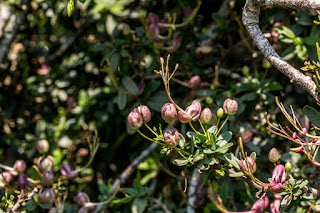While crossing this small grassland we came across several of the white form of Orthochilis ensatus - the first time we have recorded this species at Banners'.
 |
| Orthochilis ensatus white form |
 |
| Acrolophia cochlearis flowers |
 |
| Acrolophia cochlearis fruits |
The Pondoland CREW (Custodians of Rare and Endangered Wildflowers) describe their weekly botanical field trips in and around the Pondoland Centre of Endemism.
 |
| Orthochilis ensatus white form |
 |
| Acrolophia cochlearis flowers |
 |
| Acrolophia cochlearis fruits |
 |
| Rhynchocalyx lawsonioides |
 |
| Rhynchocalyx lawsonioides |
 |
| Drosera madascariensis |
 |
| Moss |
 |
| Leucadendron spissifolium subsp. oribinum - female flower |
 |
| Leucadendron spissifolium subsp. oribinum - male flower |
 |
| Alberta magna |
 |
| Eugenia natalitia |
 |
| Psychotria capensis |
 |
| Utricularia livida |
 |
| The view from the top of Anemone Falls |
 |
| Anemone brevistylis |
 |
| Looking upstream into the Umtamvuna River gorge with Anemone falls on the right |
 |
| Clutia sp. nov. |
 |
| Harveya huttonii |
 |
| Ludwigia octovalvis |
 |
| Dietes butcheriana |
 |
| Disa brevicornis |
 |
| Polystachya pubescens |
 |
| Strychnos henningsii |
 |
| Dovyalis lucida |
 |
| Dovyalis lucida |
 |
| Gerbera sp. |
 |
| Commelina africana |
 |
| Heliophila rigidiuscula |
 |
| Hibiscus pedunculatus |
 |
| Turraea pulchella |
 |
| Hilliardiella aristata |
 |
| Indigofera pondoensis |
 |
| Ledebouria ovatifolia |
 |
| Gibraltar pinnacle serves as a fine backdrop to a soaring Cape Vulture |
 |
| Osyridicarpus schimperianus |
 |
| Agelanthus kraussianus |
 |
| Cadaba natalensis |
 |
| Obetia tenax |
 |
| Lycium acutifolium |
 |
| Streptocarpus haygarthii |
 |
| Eriospermum flagelliforme |
 |
| Aspalathus abbottii - an endemic to these clifftop rock plates |
 |
| Homalium rufescens |
 |
| Crotalaria capensis |
 |
| Wahlenbergia madagascariensis |
 |
| Pondoland CREW with the UKZN team |
 |
| Interesting stump |
 |
| Pterocelastrus tricuspidatus |
 |
| Petopentia natalensis |
 |
| Acokanthera oppositiflora |
 |
| Ochna arborea fruit |
 |
| Clausena anisata |
 |
| Perched above the Umtamvuna River |